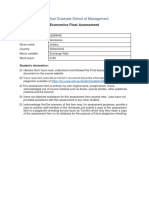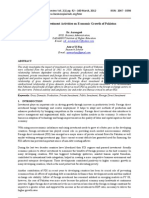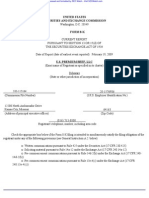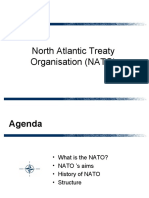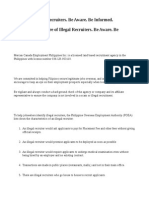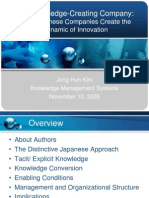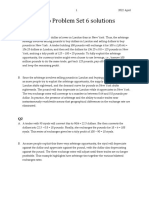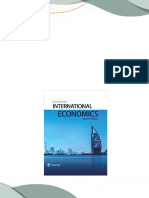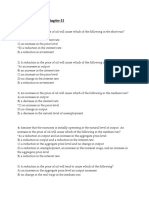Final Project of IFM
Final Project of IFM
Uploaded by
Omer MirzaCopyright:
Available Formats
Final Project of IFM
Final Project of IFM
Uploaded by
Omer MirzaOriginal Description:
Copyright
Available Formats
Share this document
Did you find this document useful?
Is this content inappropriate?
Copyright:
Available Formats
Final Project of IFM
Final Project of IFM
Uploaded by
Omer MirzaCopyright:
Available Formats
National University of Modern Languages
Submitted to:
Prof. Waseem Abbas
Submitted by:
Hasseeb-ur-Rehman Omer Ejaz
Summary
This paper investigates the impact on foreign direct investment due to the Inflation (Consumer Prices), Official Exchange Rate, GDP
(Current $ USD), GDP Growth Annual Percent Rate & Total Tax Rate of Commercial of (03) three Asian countries i.e Pakistan, Bangladesh & India. Secondary data has been gathered from the websites and articles during the time period of 1980 to 2011 for this purpose. In this paper, five variables are used INF, GDP (Current & Growth), ER, TR are taken as dependent variable whereas FDI is taken as independent variables. To assess the impact of FDI on five dependant variables, time series data regression has been used.
Introduction
The issue of economic growth asymmetry across countries continually draws academic interest and intellectual curiosity. What really contributes to this asymmetry has puzzled the minds of economists and politicians for centuries. The new millennium raises more questions and concerns about this issue. As a result, there is a growing need to study it with more rigor and depth. Many less developed countries (LDCs) have adopted outward- and forward-looking policies to promote economic growth and employment. The roles of exports, foreign direct investment (FDI) and the concomitants remittances of emigration are recognized as important economic Growth-enhancing factors.
Although the adoption of such policies by LDCs is expected to exert positive influences on overall GDP, it is uncertain how much is contributed by surging exports, FDI, and remittances. The empirics of their effects on GDP generate mixed and ambiguous inferences across countries over different sample periods and across different developing countries. Therefore, this paper re-examines the roles of these causal variables in promoting real GDP of Pakistan, Bangladesh, & Pakistan.
These three developing countries of South Asia have been selected because of emphasizing active policies of export promotion and diversification, increasing manpower exports and enticing FDI to boost economic growth as important members of SARC (South Asian Regional Cooperation). The remainder of the paper is organized as follows: section II reviews some of the related literature. Section-III outlines the empirical methodology. Section IV reports the empirical results. Finally, Section-V offers conclusions and policy implications.
Foreign Direct Investment and GDP Growth
There is conflicting evidence in the literature regarding the question as to how, and to what extent, FDI affects economic growth. FDI may affect economic growth directly because it contributes to capital accumulation, and the transfer of new technologies to the recipient country. In addition, FDI enhances economic growth indirectly where the direct transfer of technology augments the stock of knowledge in the recipient country through labor training and skill acquisition, new management practices and organizational arrangements Foreign Direct Investment (FDI) is very important to developing countries. Though foreign direct investment, individuals or corporation obtain partial or total ownership of firms located in another country. But foreign investor should have lasting interest and substantial control over the investment. FDI contribute to growth through several channels. It directly affects growth through being a source of capital formation. As a part of private investment, an increase in FDI will, by itself, contribute to an increase in total investment. An increase in investment directly contributes to growth. A large number of studies have been done in the field of foreign direct investment and economic growth. FDI is an important category of international investment that shows a long-term relationship between the direct investor and the enterprise. It indicates the influence of the investor on the management of the enterprise. Direct investment relates the initial transaction between the investor and the enterprise. It also shows the transactions between them and among affiliated enterprises, both incorporated and unincorporated.
Foreign Direct Investment and Exchange Rate
The investigation of relationship between exchange rate as well as its volatility and macroeconomic variables including foreign direct investment got significant importance in last few decades, particularly after the collapse of Bretton woods in 1971. After the collapse of this system, majority of the countries initiated the flexible/floating exchange rate system and faced huge fluctuation in the value of their currency prices.
The growing interest in foreign direct investment (FDI), stand from the perceived opportunities derivable from utilizing this form of foreign capital injection into the economy to augment domestic savings and further promote economic development in most developing economies.
FDI is believed to be stable and easier to service than bank credit. FDI are usually on long term economic activities in which repatriation of profit only occur when the project earn profit. As stated by Dunning and Rugman (1985). Foreign Direct Investment (FDI) contributes to the host countrys gross capital formation, higher growth, industrial productivity and competitiveness and other spinoff benefits such as transfer of technology, managerial expertise, improvement in the quality of human resources and increased investment.
Other factors like higher profit from investment, low labour and production cost, political stability, enduring investment climate, functional infrastructure facilities and favourable regular environment also help to attract and retain FDI in the host country.
Foreign Direct Investment and Inflation
Modern growth theory rest on the view that economic growth is the result of capital accumulation which leads to investment. Given the overriding importance of an enabling environment for investment to thrive, it is important to examine necessary conditions that facilitate FDI inflow. These are classified into economic, political, social and legal factors. The economic factors include infrastructural facilities, favorable fiscal, monetary, trade and exchange rate policies. The degree of openness of the domestic economy, tariff policy, credit provision by a countrys banking system, indigenization policy, the economys growth potentials, market size and macroeconomic stability. Other factors like higher profit from investment, low labour and production cost, political stability, enduring investment climate, functional infrastructure facilities and favourable regulatory environment also help to attract and retain FDI in the host country. Inflation as this term was always used everywhere and especially in these countries, it is defined as increasing the quantity of money and bank notes in circulation and the quantity of bank deposits subject to check. But most of the citizens today use the term inflation to refer to the phenomenon that is a certain outcome of inflation, that is the tendency of all prices & wage rates to rise. Foreign Direct investment can also be describe as an investment made by an investor or enterprises in another enterprises or equivalent in voting power or other means of control in another country with the aim to manage the investment and maximize profit. This investment involves not only the transfer of fund but also the transfer of physical capital, technique of production managerial and marketing expertise, product advertising and business practice with the aim to make profit. Other factors like higher profit from investment, low labour and production cost, political stability, enduring investment climate, functional infrastructure facilities and favourable regular environment.
Foreign Direct Investment and GDP Current
In measuring the impact of FDI on GDP, we expect the FDI that has come into the host country this year to contribute to an increase in the FDP from next year onwards. Note that FDI inflows in any year represent in general, the increase in FDI inward stock as defined in the World Investment Reports. Since FDI is reported in current US$, we use the GDP data also measured in current US$ to maintain consistency.
After the global financial crisis, the status and importance of Asian economies have increased a lot because of their more than expected resilience to financial crisis. Asian economies are expanding rapidly and their growing clout can be felt from the fact that out of top 5 economies of the world 3 are Asian. Asia, with the exception of Japan, South Korea, Hong Kong and Singapore, is currently undergoing rapid growth and industrialization spearheaded by China and India - the two fastest growing major economies in the world but in the present paper we have taken the economies of 3 countries i.e Pakistan, Bangladesh & India.
FDI can accelerate growth in the ways of generating employment in the countries, fulfilling saving gap and huge investment demand and sharing knowledge and management skills through backward and forward linkage in the countries.
Foreign Direct Investment and Tax Rate
Tax is classified into two main categories that is direct and indirect taxation. Direct tax is imposed on properties, incomes and corporate profits etc. Indirect tax includes value added tax, sales tax and import duty etc. In case of direct taxes, tax revenue depends on a countrys policy, either it relaxes the direct taxes for attracting foreign investment or imposes to collect revenue. For example, tax holidays and tax credits for new foreign investment and exemption of import duty in case of imports of raw material and machinery. Secondly, indirect tax depends on the sales of goods and services. FDI has generally positive effect on the economic growth and income levels in a country, so there will be greater aggregate demand and economic activities in a country which could help the government to generate more indirect taxes. In case of Pakistan, major proportion of tax revenue is collected through indirect taxes. So, FDI may have positive impact on the tax revenue in Pakistan. According to Bond and Samuelson (1986), host countries could lose some tax revenue in short run if tax holidays were given to attract FDI in early period. Tax revenue could increase in the long run because foreign investment would not pull out after that tax holiday period. Brander and Spencer (1987) stated that host countries could attract FDI by imposing tariff on imports and relaxing the tax on local production. It was stated that FDI could enhance national welfare by reducing unemployment, rising productivity through technology transfers and raising government revenue through taxation.
Empirical Results
You might also like
- Request An R204 (C) Letter of Support: New Brunswick Provincial Nominee Program (NBPNP)Document2 pagesRequest An R204 (C) Letter of Support: New Brunswick Provincial Nominee Program (NBPNP)sudarshansunar96No ratings yet
- Military Installations and ...Document102 pagesMilitary Installations and ...METANOIA100% (1)
- Analysis of CHF Exchange Rate, 2010-11Document12 pagesAnalysis of CHF Exchange Rate, 2010-11Joshua GonsalvesNo ratings yet
- Do Consumers Really Trust Cryptocurrencies?: Denni Arli Patrick Van EschDocument17 pagesDo Consumers Really Trust Cryptocurrencies?: Denni Arli Patrick Van EschsevaletotoNo ratings yet
- International Business Vs Domestic BusinessDocument2 pagesInternational Business Vs Domestic BusinessYanira BorobiaNo ratings yet
- Nigeria Foreign Policy Under Military Administration (Case Study of Murtala-Obasanjo Adminstration-1Document59 pagesNigeria Foreign Policy Under Military Administration (Case Study of Murtala-Obasanjo Adminstration-1Onwuka Francis100% (2)
- Egov 1H 2020 Verint PDFDocument20 pagesEgov 1H 2020 Verint PDFNa NaNo ratings yet
- Day / Month / Year: Certificate of No Criminal Conviction Applicant Data Collection Form (LOCAL)Document4 pagesDay / Month / Year: Certificate of No Criminal Conviction Applicant Data Collection Form (LOCAL)Lhea RecenteNo ratings yet
- 2015 AMG Final PDFDocument280 pages2015 AMG Final PDFLarissa FriedmannNo ratings yet
- DiplomaticDocument70 pagesDiplomaticFaisal SulimanNo ratings yet
- j58 S4hana2020 BPD en UsDocument114 pagesj58 S4hana2020 BPD en Usravi kNo ratings yet
- Impact of Investment Activities On Economic Growth of PakistanDocument9 pagesImpact of Investment Activities On Economic Growth of PakistanMuhammad ImranNo ratings yet
- Relationship Between FDI and GDPDocument25 pagesRelationship Between FDI and GDPruchikadamani100% (3)
- Impact of Foreign Direct Investment On Economic GrowthDocument9 pagesImpact of Foreign Direct Investment On Economic GrowthmuhammadNo ratings yet
- Impact of Foreign Direct Investment On Economic Growth of NepalDocument70 pagesImpact of Foreign Direct Investment On Economic Growth of NepalDavid MakangeNo ratings yet
- Military Magazine ENGDocument52 pagesMilitary Magazine ENGCompanhia de Engenharia de Força de Paz - HaitiNo ratings yet
- Malawi Investment PortfolioDocument66 pagesMalawi Investment PortfoliovijaybalareddyNo ratings yet
- Vietnam Investment HandbookDocument34 pagesVietnam Investment HandbookThi Phuong Thoa LaNo ratings yet
- Procedures For Investing in Tanzania and Its IncentivesDocument8 pagesProcedures For Investing in Tanzania and Its Incentiveso-consultNo ratings yet
- Foreign Military Bases Position PapersDocument32 pagesForeign Military Bases Position PapersHong Kong MUN 2013100% (2)
- Afman10-401v2 Planning FormatsDocument504 pagesAfman10-401v2 Planning FormatsMoncho GarayNo ratings yet
- AttachmentDocument15 pagesAttachmentDada blessingNo ratings yet
- Final Report On KFC Restaurant Joint Research Project: EN4505 Cross Cultural Organizational CommunicationDocument49 pagesFinal Report On KFC Restaurant Joint Research Project: EN4505 Cross Cultural Organizational CommunicationRajan GaurNo ratings yet
- Trade Related Investment Policy Framework Pakistan 2015 23Document11 pagesTrade Related Investment Policy Framework Pakistan 2015 23Mohammad Masboor0% (1)
- Chinas Foreign Investment Law - Moving Toward Greater LiberalizatDocument85 pagesChinas Foreign Investment Law - Moving Toward Greater LiberalizatAshfaq ShaonNo ratings yet
- Financial Statement Europe Trust 2006Document24 pagesFinancial Statement Europe Trust 2006Peter ShettyNo ratings yet
- Citizen Charter.: A Mysandesham PresentationDocument137 pagesCitizen Charter.: A Mysandesham PresentationJames AdhikaramNo ratings yet
- Visa ChecklistDocument3 pagesVisa ChecklistAvin GoyalNo ratings yet
- Vision: Personality Test Programme 2019Document6 pagesVision: Personality Test Programme 2019BEeNaNo ratings yet
- AP Office 3Q 2011Document28 pagesAP Office 3Q 2011Colliers InternationalNo ratings yet
- 2017 ITF Duties and ProceduresDocument45 pages2017 ITF Duties and ProceduresMoisi DragosNo ratings yet
- The Impact of Financial Development On Economic Growth of NigeriaDocument13 pagesThe Impact of Financial Development On Economic Growth of NigeriaPORI ENTERPRISESNo ratings yet
- BBM Project FormatDocument2 pagesBBM Project FormatNikita RaoNo ratings yet
- The Foreign Direct InvestmentDocument2 pagesThe Foreign Direct InvestmentNina RichieNo ratings yet
- Kama Company ProfileDocument4 pagesKama Company ProfileRahil JainNo ratings yet
- South Africa Bank Loans InformationDocument3 pagesSouth Africa Bank Loans InformationFrancois Vd MerweNo ratings yet
- UNIT 1 E Payment SystemDocument76 pagesUNIT 1 E Payment SystemRahul DesuNo ratings yet
- Book Review: Nepal's Foreign Policy and Its NeighboursDocument7 pagesBook Review: Nepal's Foreign Policy and Its NeighboursmegaNo ratings yet
- U. S. Premium Beef, LLC 8-K (Events or Changes Between Quarterly Reports) 2009-02-20Document3 pagesU. S. Premium Beef, LLC 8-K (Events or Changes Between Quarterly Reports) 2009-02-20http://secwatch.comNo ratings yet
- North Atlantic Treaty Organisation (NATO)Document13 pagesNorth Atlantic Treaty Organisation (NATO)Chucky Phillipmorris100% (2)
- Malawi Investment OpportunitiesDocument60 pagesMalawi Investment Opportunitieszengani@gmail.comNo ratings yet
- Economic Diplomacy - Basics: Kishan S RanaDocument16 pagesEconomic Diplomacy - Basics: Kishan S Ranaizmxxx wuNo ratings yet
- Rep. Jeremy Durham's Letter On Behalf of Joseph Todd NeillDocument2 pagesRep. Jeremy Durham's Letter On Behalf of Joseph Todd NeillUSA TODAY Network100% (1)
- ATMIS Newly Deployed Senior Military Officers InductedDocument3 pagesATMIS Newly Deployed Senior Military Officers InductedAMISOM Public Information ServicesNo ratings yet
- Determinants of Fdi Case of Mauritius PDFDocument106 pagesDeterminants of Fdi Case of Mauritius PDFain_bemisal13100% (1)
- Transaction Banking: in Standard Chartered Bank BangladeshDocument52 pagesTransaction Banking: in Standard Chartered Bank BangladeshMahmudul HaqueNo ratings yet
- Invoice (Faktura) : Tax-Free Export Delivery Tax-Free Export DeliveryDocument1 pageInvoice (Faktura) : Tax-Free Export Delivery Tax-Free Export DeliveryFischer AutomotiveNo ratings yet
- Focus NigeriaDocument14 pagesFocus NigeriaKarlen Zamora ZúñigaNo ratings yet
- TIOB March Magazine 2024 - 240306 - 162000Document28 pagesTIOB March Magazine 2024 - 240306 - 162000Anonymous FnM14a0No ratings yet
- Mercan Canada & POEA InfosDocument9 pagesMercan Canada & POEA InfosJason TiongcoNo ratings yet
- EmtechDocument6 pagesEmtechEunice AlcantaraNo ratings yet
- An Empirical Analysis of The Effect of FDocument21 pagesAn Empirical Analysis of The Effect of FDavidNo ratings yet
- I2 Presentation Money Trail v3Document42 pagesI2 Presentation Money Trail v3772748_nareshNo ratings yet
- HK Law Fair BrochureDocument30 pagesHK Law Fair BrochurejessiecakesNo ratings yet
- Impact of Fdi On Economic Growth in Pakistan ThesisDocument8 pagesImpact of Fdi On Economic Growth in Pakistan ThesisWriteMyPaperReviewsOverlandPark100% (2)
- 16-219-237 A Study On The Effects of FDI On Cambodia's Economic Growth by HUON Sophanara-FinalDocument19 pages16-219-237 A Study On The Effects of FDI On Cambodia's Economic Growth by HUON Sophanara-Finalphang brostouchNo ratings yet
- An Impact Assessement of Foreing Direct Investment and Export Volume On Economic Growth in Nigeria.Document12 pagesAn Impact Assessement of Foreing Direct Investment and Export Volume On Economic Growth in Nigeria.Miftahu IdrisNo ratings yet
- Vol22 Art2 PDFDocument21 pagesVol22 Art2 PDFIsmith PokhrelNo ratings yet
- Literature Review (GDP Growth)Document2 pagesLiterature Review (GDP Growth)Omer MirzaNo ratings yet
- Determinants of Foreign Direct Investment in Nigeria "Evidence From Co-Integration and Error Correction Modeling"Document10 pagesDeterminants of Foreign Direct Investment in Nigeria "Evidence From Co-Integration and Error Correction Modeling"Mintu PaulNo ratings yet
- Factors That Affact FDIDocument7 pagesFactors That Affact FDINajmul IslamNo ratings yet
- Foreign Direct InvestmentDocument6 pagesForeign Direct InvestmentOmer MirzaNo ratings yet
- Chapter 9Document9 pagesChapter 9Tasleem Faraz MinhasNo ratings yet
- RBS & Faysal BankDocument13 pagesRBS & Faysal BankOmer MirzaNo ratings yet
- 2 Creating Business Advantage With ITDocument14 pages2 Creating Business Advantage With ITOmer MirzaNo ratings yet
- Irfan Final Ifm TodayDocument13 pagesIrfan Final Ifm TodayOmer MirzaNo ratings yet
- Organizational Knowledge Creation Theory - Evolutionary Paths and Future AdvancesDocument31 pagesOrganizational Knowledge Creation Theory - Evolutionary Paths and Future AdvancesOmer MirzaNo ratings yet
- University Recommended BooksDocument29 pagesUniversity Recommended BooksOmer Mirza50% (2)
- Kim Knowledge Creating CompanyDocument18 pagesKim Knowledge Creating CompanyOmer MirzaNo ratings yet
- Literature Review (GDP Growth)Document2 pagesLiterature Review (GDP Growth)Omer MirzaNo ratings yet
- SBUs of MobilinkDocument12 pagesSBUs of MobilinkOmer Mirza100% (1)
- Organizational Knowledge Creation Theory - Evolutionary Paths and Future AdvancesDocument31 pagesOrganizational Knowledge Creation Theory - Evolutionary Paths and Future AdvancesOmer MirzaNo ratings yet
- 5th Semester nIGHT Jan 2013Document2 pages5th Semester nIGHT Jan 2013Omer MirzaNo ratings yet
- Nod 32Document1 pageNod 32Omer MirzaNo ratings yet
- Mitigating Foreign Investment Risk in UzbekistanDocument28 pagesMitigating Foreign Investment Risk in UzbekistanmhktaiNo ratings yet
- Macro Problem Set 6 SolutionsDocument4 pagesMacro Problem Set 6 SolutionsGenna NgNo ratings yet
- FFMC Rbi DocsDocument51 pagesFFMC Rbi DocsManikNo ratings yet
- Section A (Multiple Choice Questions) : Ractice EcturesDocument4 pagesSection A (Multiple Choice Questions) : Ractice Ecturesolaef1445No ratings yet
- CB With FC Saiful Sir Class SmaDocument23 pagesCB With FC Saiful Sir Class SmaFahadNo ratings yet
- Fund6e Chp11 PbmsDocument10 pagesFund6e Chp11 Pbmsn.iremodaciNo ratings yet
- IBT - 07 Quiz 1Document2 pagesIBT - 07 Quiz 1stella hallareNo ratings yet
- Impact of ForexDocument7 pagesImpact of ForexmichaelegobezieNo ratings yet
- New Microsoft Word DocumentDocument4 pagesNew Microsoft Word DocumentDr. Chitra RNo ratings yet
- Journal of World Business: David M. Kemme, Bhavik Parikh, Tanja Steigner TDocument12 pagesJournal of World Business: David M. Kemme, Bhavik Parikh, Tanja Steigner Talya mukhbitaNo ratings yet
- Study of Asian Financial Crisis 1997Document26 pagesStudy of Asian Financial Crisis 1997Sudeep Sahu100% (1)
- A3 Financial MarketDocument8 pagesA3 Financial MarketPhuong Anh TranNo ratings yet
- Download Full (Original PDF) International Economics 7th Edition by James Gerber PDF All ChaptersDocument56 pagesDownload Full (Original PDF) International Economics 7th Edition by James Gerber PDF All Chapterskraarhamasi100% (4)
- ECON 2H03 Test BankDocument31 pagesECON 2H03 Test BankAiden MawjiNo ratings yet
- Macroeconomics - CHAPTER 11 FOREIGN EXCHANGE RATE NOTESDocument11 pagesMacroeconomics - CHAPTER 11 FOREIGN EXCHANGE RATE NOTESmehdi.qassim1988No ratings yet
- EEI2019 Cuba enDocument6 pagesEEI2019 Cuba enohpppNo ratings yet
- Working With Warranty Claims and Supplier Recovery ClaimsDocument22 pagesWorking With Warranty Claims and Supplier Recovery ClaimsGaryNo ratings yet
- Determinants of Foreign Direct Investment in EthiopiaDocument34 pagesDeterminants of Foreign Direct Investment in Ethiopiakedir mohammedNo ratings yet
- Bernard Connolly EuropeDocument12 pagesBernard Connolly EuropeZerohedgeNo ratings yet
- Global Cost Accounting Add inDocument36 pagesGlobal Cost Accounting Add inmayeux0% (1)
- Edexcel Economics (A) A-Level Theme 4: A Global PerspectiveDocument33 pagesEdexcel Economics (A) A-Level Theme 4: A Global Perspectiveggg182048No ratings yet
- Iii. International Trade: A. Gains From Trade - A History of Thought ApproachDocument11 pagesIii. International Trade: A. Gains From Trade - A History of Thought ApproachAjay KaundalNo ratings yet
- EC3102 Macroeconomic Analysis II Questions and Answers Prepared by Ho Kong Weng Tutorial 10Document5 pagesEC3102 Macroeconomic Analysis II Questions and Answers Prepared by Ho Kong Weng Tutorial 10Chiew Jun Siew0% (1)
- Lecture 4 - Determining Foreign Exchange RatesDocument40 pagesLecture 4 - Determining Foreign Exchange RateslekokoNo ratings yet
- Financial Analysis 4Document27 pagesFinancial Analysis 4Chin FiguraNo ratings yet
- Namma Kalvi 12th Economics Slow Learners Study Material Reduced Syllabus em 219762Document60 pagesNamma Kalvi 12th Economics Slow Learners Study Material Reduced Syllabus em 219762pudupetbrothersNo ratings yet
- Ps 2Document8 pagesPs 2Amy BeansNo ratings yet
- Chapter 2Document55 pagesChapter 2vanhuyennguyen2003No ratings yet


